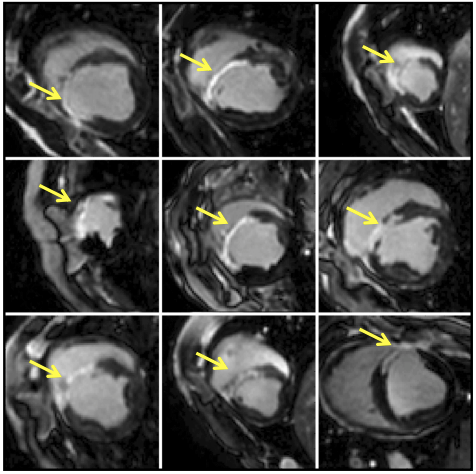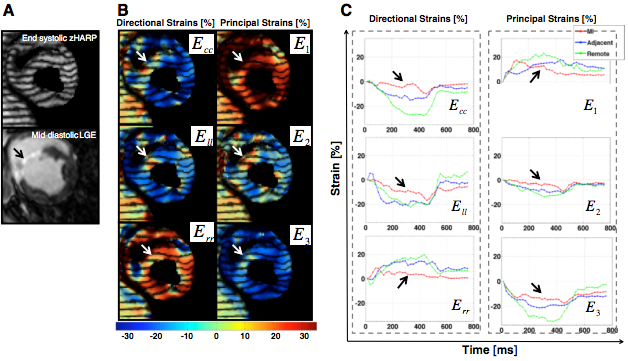Three-dimensional regional strain analysis in myocardial infarction
<meta name="title" content="Three-dimensional regional strain analysis in myocardial infarction" />
Three-dimensional regional strain analysis in myocardial infarction
Sahar Soleimanifard, Khaled Z Abd-Elmoniem, Tetsuo Sasano, Harsh K Agarwal, M Roselle Abraham, Theodore P Abraham, and Jerry L Prince
This page is under construction.
Introduction
Before advances in cardiovascular magnetic resonance (CMR) methods allowed for three-dimensional (3D) interrogation of myocardial strain, one-dimensional (1D) and two dimensional (2D) strain analysis was the standard. The aim of this study was to investigate the incremental value of CMR-based 3D strain and to test the hypothesis that 3D strain is superior to 1D or 2D strain analysis in the assessment of viability using a porcine model of infarction.
Method
All animal studies complied with the Institutional Animal Care and Use Committee and conformed to Guide for the Care and Use of Laboratory Animals.
MI was induced in twenty young farm pigs with weights from twenty five to thirty five kilograms. An Angioplasty balloon was inserted into the left anterior descending coronary artery (LAD) and inflated to a location just distal to the second diagonal branch of the LAD. After One hundred and fifty minutes, the occlusion of the artery was terminated. All surviving animals progressed to heart failure and were monitored daily.
Images then were acquired at 11±6 days (baseline) pre-MI, and at 11±4 days (early) and 34±8 days (late) post-MI. In all animals, Cine, LGE (late gadolinium enhancement), and CMR tagging images (zHARP images) were all acquired. Harmonic phase analysis was performed to measure circumferential, longitudinal, and radial strains in myocardial segments, which were defined based on the transmurality of delayed enhancement. Univariate, bivariate, and multivariate logistic regression models of strain parameters were created and analyzed to compare the overall diagnostic accuracy of 3D strain analysis with 1D and 2D analyses in identifying the infarct and its adjacent regions from healthy myocardium.
|
Cine and LGE images were analyzed using QMass and MR software. LV epicardial and endocardial borders, excluding papillary muscles, were traced in end-diastolic and end-systolic cine short-axis images to measure global function. The semi-automated full-width-at-half-maximum method was employed to identify the infarct zone on LGE images. The cine and LGE images were analyzed prior to the strain analysis in a blinded manner. For each zHARP slice, the closest LGE slice was identified and mapped to its corresponding mid-diastolic zHARP image using an affine registration.
Results
|
Out of the twenty animals, five died due to incessant ventricular fibrillation. Surviving animals all completed the imaging protocol. 3D strain differed significantly in infarct, adjacent, and remote segments (p < 0.05) at early and late post-MI. In univariate, bivariate, and multivariate analyses, circumferential, longitudinal, and radial strains were significant factors (p < 0.001) in differentiation of infarct and adjacent segments from baseline values. In identification of adjacent segments, receiver operating characteristic analysis using the 3D strain multivariate model demonstrated a significant improvement (p < 0.01) in overall diagnostic accuracy. Overall, 3D strain analysis showed a 96% diagnostic accuracy with 2D strain analysis showing an 81% diagnostic accuracy with 1D strain analysis left at 71% diagnostic accuracy.
Conclusion
3D strain analysis showed to be 15% more accurate than 2D strain analysis and 25% more accurate than 1D strain analysis when it came to diagnostic accuracy. Multivariate 3D strain analysis using CMR accurately differentiates infarct from normal myocardium and correlates with delayed enhancement. Furthermore, cumulative 3D strain is superior to 1D and 2D strain analyses for identification of infarct neighboring regions. Using this technique on human subjects will help determine the clinical value of 3D regional strain quantification.
Acknowledgments
We thank Evert-Jan Vonken, MD, PhD, and Michael Schär, PhD for kindly providing the technical expertise with CMR acquisitions, and Amr Youssef, MD for help with animal studies. This work was supported in part by NIH/NHLBI research grant R01HL47405.
Publications
- S. Soleimanifard, K.Z. Abd-Elmoniem, T. Sasano, H.K. Agarwal, M.R. Abraham, T.P. Abraham, and J.L. Prince, "Three-dimensional regional strain analysis in porcine myocardial infarction: a 3T magnetic resonance tagging study", Journal of Cardiovascular Magnetic Resonance, 14(85), 2012. (doi)
- N.F. Osman, S. Sampath, E. Atalar, and J.L. Prince, "Imaging longitudinal cardiac strain on short-axis images using strain-encoded MRI", Magnetic Resonance in Medicine, 46:324-334, 2001. (PubMed)
- L. Pan, J.L. Prince, J.A.C. Lima, and N.F. Osman, "Fast tracking of cardiac motion using 3D-HARP", IEEE Trans. on Biomedical Engineering, 52: 1425-1435, 2005. (PubMed)
- K.Z. Abd-Elmoniem, N.F. Osman, J.L. Prince, and M. Stuber, "Three-dimensional magnetic resonance myocardial motion tracking from a single image plane", Magnetic Resonance in Medicine, 58:92-102, 2007. (PubMed)
- K.Z. Abd-Elmoniem, M. Stuber, and J.L. Prince, "Direct three-dimensional myocardial strain tensor quantification and tracking using zHarp", Medical Image Analysis, 12:778-786, 2008. (doi)
- K.Z. Abd-Elmoniem, M.S. Tomas, T. Sasano, S. Soleimanifard, E.P. Vonken, A. Youssef, H. Agarwal, V.L. Dimaano, H. Calkins, M. Stuber, J.L. Prince, T.P. Abraham, and M.R. Abraham, "Assessment of Distribution and Evolution of Mechanical Dyssynchrony in a Porcine Model of Myocardial Infarction by Cardiac Magnetic Resonance Imaging", Journal of Cardiovascular Magnetic Resonance, 14(1), 2012. (doi)




